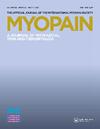Visual Analog Scale and Pressure Pain Threshold for Delayed Onset Muscle Soreness Assessment
引用次数: 61
Abstract
Abstract Objectives: To investigate the relationship between two assessments to quantify delayed onset muscle soreness [DOMS]: visual analog scale [VAS] and pressure pain threshold [PPT]. Methods: Thirty-one healthy young men [25.8 ± 5.5 years] performed 10 sets of six maximal eccentric contractions of the elbow flexors with their non-dominant arm. Before and one to four days after the exercise, muscle pain perceived upon palpation of the biceps brachii at three sites [5, 9 and 13 cm above the elbow crease] was assessed by VAS with a 100 mm line [0 = no pain, 100 = extremely painful], and PPT of the same sites was determined by an algometer. Changes in VAS and PPT over time were compared amongst three sites by a two-way repeated measures analysis of variance, and the relationship between VAS and PPT was analyzed using a Pearson product-moment correlation. Results: The VAS increased one to four days after exercise and peaked two days post-exercise, while the PPT decreased most one day post-exercise and remained below baseline for four days following exercise [p < 0.05]. No significant difference among the three sites was found for VAS [p = 0.62] or PPT [p = 0.45]. The magnitude of change in VAS did not significantly correlate with that of PPT [r = −0.20, p = 0.28]. Conclusion: These results suggest that the level of muscle pain is not region-specific, at least among the three sites investigated in the study, and VAS and PPT provide different information about DOMS, indicating that VAS and PPT represent different aspects of pain.延迟性肌肉酸痛评估的视觉模拟量表和压痛阈值
目的:探讨两种量化迟发性肌肉酸痛(DOMS)的评估方法:视觉模拟量表(VAS)和压痛阈值(PPT)之间的关系。方法:31例健康青年[25.8±5.5岁],用非优势臂进行10组6次肘关节屈肌最大偏心收缩。运动前和运动后1 ~ 4天,采用VAS以100 mm线(0 =无痛,100 =极痛)评估肱二头肌在肘部折痕以上5、9、13 cm处触诊的肌肉疼痛,并采用测痛仪测定相同部位的PPT。通过双向重复测量方差分析比较三个地点的VAS和PPT随时间的变化,并使用Pearson积差相关分析VAS和PPT之间的关系。结果:VAS在运动后1 ~ 4天升高,运动后2天达到峰值,PPT在运动后1天下降最多,运动后4天保持在基线以下[p < 0.05]。三个部位的VAS评分[p = 0.62]和PPT评分[p = 0.45]差异无统计学意义。VAS变化幅度与PPT变化幅度无显著相关[r = - 0.20, p = 0.28]。结论:这些结果表明,至少在研究的三个部位中,肌肉疼痛的水平不是区域特异性的,VAS和PPT提供了关于DOMS的不同信息,表明VAS和PPT代表了疼痛的不同方面。
本文章由计算机程序翻译,如有差异,请以英文原文为准。
求助全文
约1分钟内获得全文
求助全文

 求助内容:
求助内容: 应助结果提醒方式:
应助结果提醒方式:


